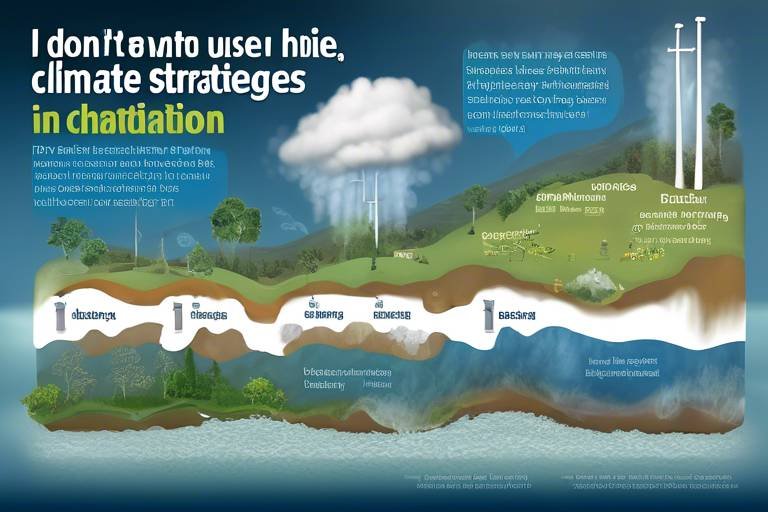The Latest Research on Climate Change Adaptation
Climate change is no longer just a looming threat; it's a reality that we are facing today. As temperatures rise, weather patterns shift, and natural disasters become more frequent, the need for effective climate change adaptation strategies has never been more critical. This article explores recent findings on these adaptation strategies, shedding light on innovative approaches, the challenges faced, and the importance of building resilience within communities worldwide.
So, what exactly is climate change adaptation? At its core, it involves making adjustments to our practices, processes, and structures to minimize the damage caused by the impacts of climate change. This isn't just about reacting to changes; it's about proactively preparing for them. The significance of adaptation cannot be overstated. Communities that adopt these strategies can better withstand the effects of climate change, whether that means rising sea levels, increased flooding, or more intense heatwaves. Across the globe, various regions are employing a range of strategies tailored to their unique challenges. From agricultural practices to urban planning, adaptation is a multifaceted endeavor that requires collaboration and innovation.
Recent research is shining a spotlight on some truly cutting-edge adaptation strategies. These include both nature-based solutions and technological innovations, which help communities not only survive but thrive in the face of climate challenges. Let's dive into some successful case studies that illustrate effective implementation in various environmental contexts.
Nature-based solutions (NbS) are gaining traction as a powerful way to harness ecosystem services to tackle climate challenges. By restoring ecosystems, we can enhance resilience and provide sustainable benefits to communities facing climate risks. For instance, consider how restoring wetlands can help absorb floodwaters, thus protecting nearby urban areas. The beauty of NbS lies in their dual benefits: they not only mitigate climate impacts but also promote biodiversity and improve quality of life.
In urban settings, green spaces play a vital role in climate adaptation. Parks, gardens, and green roofs can significantly mitigate the heat effects caused by urbanization. They not only provide a refuge for biodiversity but also offer residents a place to connect with nature. Research has shown that cities with ample green spaces experience lower temperatures, improved air quality, and enhanced mental well-being among their inhabitants. It's a win-win situation that contributes to overall community resilience.
Coastal areas are particularly vulnerable to climate change, making coastal restoration projects critical for protecting these shorelines. Successful initiatives around the world have demonstrated how restoring natural habitats, such as mangroves and coral reefs, can reduce erosion and enhance community resilience against rising sea levels. For example, the restoration of mangrove forests not only provides a buffer against storm surges but also supports local fisheries, creating a sustainable livelihood for coastal communities.
As we venture further into the 21st century, technological advancements are transforming climate adaptation efforts. Emerging technologies, such as climate modeling and smart infrastructure, are supporting decision-making processes and enhancing adaptive capacity. For instance, climate modeling helps predict future climate scenarios, allowing communities to prepare for potential impacts. Smart infrastructure, on the other hand, incorporates sensors and data analytics to monitor environmental conditions in real-time, making it easier to respond to changes as they happen.
Despite the progress being made, numerous challenges still hinder effective adaptation. Identifying and addressing these barriers is crucial for successful implementation. Key challenges include financial constraints, political will, and public awareness. Each of these factors plays a significant role in determining the effectiveness of adaptation strategies across different regions.
One of the most significant barriers to climate adaptation is funding. Without adequate financial resources, many communities struggle to implement necessary changes. Various financial mechanisms, such as grants and loans, are available, but there is a pressing need for increased investment to support vulnerable communities and their infrastructure. The question remains: how can we mobilize the necessary funds to ensure that everyone has the opportunity to adapt?
Political and social factors can also impede adaptation efforts. Governance structures and community engagement are critical in influencing the effectiveness of adaptation strategies. When local communities are involved in the decision-making process, they are more likely to support and participate in adaptation initiatives. This engagement fosters a sense of ownership and responsibility, which is essential for long-term success.
Community involvement is absolutely essential for successful adaptation. When local knowledge and participation are prioritized, solutions can be tailored to resonate with the specific needs of affected populations. Engaging communities not only empowers individuals but also fosters collaboration, leading to more effective and sustainable adaptation strategies. Ultimately, the success of climate change adaptation hinges on our ability to work together, leveraging both local insights and innovative approaches to build a resilient future.
- What is climate change adaptation? Climate change adaptation involves adjusting practices and structures to minimize damage caused by climate impacts.
- Why are nature-based solutions important? They harness ecosystem services to enhance resilience and provide sustainable benefits to communities.
- What are the main challenges in climate change adaptation? Key challenges include financial constraints, political will, and public awareness.
- How can communities get involved in adaptation efforts? Community engagement is crucial; local knowledge and participation lead to more effective solutions.

Understanding Climate Change Adaptation
Climate change adaptation is not just a buzzword; it’s a crucial response to one of the most pressing issues of our time. As our planet heats up, weather patterns become erratic, and communities face challenges that threaten their very existence. So, what exactly does it mean to adapt? In simple terms, it involves making adjustments in our practices, processes, and structures to lessen the impact of climate change. Think of it like upgrading your home’s insulation before winter hits; it’s all about being proactive rather than reactive.
This adaptation is significant for several reasons. First, it helps to minimize damage from climate impacts, which can range from extreme weather events to long-term environmental shifts. For example, communities in coastal areas are increasingly investing in flood defenses and restoring wetlands to buffer against rising sea levels. These measures not only protect homes and businesses but also preserve local ecosystems. Second, adaptation enhances resilience, allowing communities to bounce back more quickly from climate-related disruptions.
Across the globe, various strategies are being employed to tackle these challenges. In urban areas, cities are turning to green infrastructure, such as parks and green roofs, to combat the heat island effect and improve air quality. Meanwhile, rural communities are exploring sustainable agricultural practices that can withstand droughts and floods. The beauty of adaptation lies in its diversity; what works in one region may not be suitable for another, making local context critical.
It’s also important to recognize that adaptation is not a one-time fix but an ongoing process. As climate conditions evolve, so too must our strategies. This requires a commitment to continuous learning and adjustment. Here’s a quick overview of some common adaptation strategies:
| Adaptation Strategy | Description |
|---|---|
| Infrastructure Improvements | Upgrading roads, bridges, and buildings to withstand extreme weather. |
| Water Management | Implementing systems for efficient water use and flood control. |
| Ecosystem Restoration | Restoring natural habitats to enhance biodiversity and resilience. |
In summary, understanding climate change adaptation is about recognizing the need for proactive measures that empower communities to face the future with confidence. It’s not just about survival; it’s about thriving in a world that is constantly changing. As we delve deeper into innovative strategies and the challenges we face, it becomes clear that adaptation is a collective journey that requires collaboration, creativity, and a commitment to sustainability.

Innovative Adaptation Strategies
In the face of escalating climate challenges, are emerging as lifelines for communities striving to cope with the inevitable impacts of climate change. These strategies are not merely reactive; they represent a proactive approach to safeguarding our environment and enhancing community resilience. Recent research showcases a variety of groundbreaking methods, from nature-based solutions that leverage the power of ecosystems to high-tech technological innovations designed to optimize our adaptation efforts.
One of the most compelling aspects of these strategies is their ability to integrate traditional knowledge with modern practices. For instance, communities around the globe are recognizing the value of local ecosystems in their adaptation plans. By restoring wetlands, reforesting areas, and creating urban green spaces, they are not only improving their immediate environment but also boosting biodiversity and enhancing their capacity to withstand climate impacts. This dual approach not only addresses immediate environmental concerns but also fosters a sense of community ownership and responsibility.
Nature-based solutions (NbS) are increasingly gaining traction as effective climate adaptation strategies. These solutions utilize the natural world to mitigate the effects of climate change. For example, restoring mangroves and wetlands can significantly reduce coastal erosion and enhance flood protection. Research indicates that such ecosystems can absorb up to 70% of storm surge energy, providing a natural barrier against rising sea levels.
Moreover, NbS are not just about protection; they also offer sustainable benefits to communities. By investing in the restoration of natural habitats, communities can create spaces that provide clean air, recreational opportunities, and improved mental health. The following table illustrates some successful nature-based projects around the world:
| Project Name | Location | Focus Area | Outcome |
|---|---|---|---|
| Green Roofs Initiative | New York City, USA | Urban Green Spaces | Reduced urban heat island effect and improved air quality. |
| Mangrove Restoration Project | Bangladesh | Coastal Protection | Enhanced coastal resilience and biodiversity. |
| Wetland Restoration | California, USA | Flood Mitigation | Improved water quality and habitat for wildlife. |
Urban areas are often the most affected by climate change, experiencing higher temperatures and increased flooding. The creation of urban green spaces, such as parks and green roofs, is a crucial adaptation strategy. These spaces not only provide a refuge for local wildlife but also serve as essential cooling zones for city dwellers. By incorporating vegetation into urban planning, cities can reduce the urban heat island effect, improve air quality, and enhance the overall quality of life for residents.
As rising sea levels threaten coastal communities, restoration projects are becoming vital. These initiatives focus on restoring natural habitats, such as coral reefs and mangroves, that act as buffers against storms and erosion. For instance, communities that have invested in coastal restoration have seen significant reductions in property damage during storms. By protecting these natural barriers, we not only safeguard our infrastructure but also promote biodiversity and support local fisheries.
On the other side of the innovation spectrum, technological advancements are playing a pivotal role in climate adaptation. Emerging technologies, such as climate modeling and smart infrastructure, are transforming how communities approach adaptation. With sophisticated climate models, cities can predict potential climate impacts and plan accordingly. This foresight allows for better resource allocation and more effective emergency response strategies.
Smart infrastructure, which includes everything from sensors that monitor environmental conditions to AI-driven systems that optimize energy use, is also enhancing adaptive capacity. These technologies enable real-time data collection and analysis, empowering communities to make informed decisions that strengthen their resilience to climate change.
- What are nature-based solutions? Nature-based solutions are strategies that use natural processes and ecosystems to address environmental challenges, such as climate change.
- How do urban green spaces help with climate adaptation? Urban green spaces mitigate heat, improve air quality, and provide recreational opportunities, enhancing overall community resilience.
- What role does technology play in climate adaptation? Technology aids in predicting climate impacts and optimizing infrastructure, allowing communities to make data-driven decisions for better adaptation.

Nature-Based Solutions
Nature-based solutions (NbS) have emerged as a groundbreaking approach to tackling the multifaceted challenges posed by climate change. These solutions leverage the power of natural ecosystems to mitigate climate impacts while simultaneously providing a plethora of benefits to communities. Imagine a world where our cities are not just concrete jungles but vibrant ecosystems that breathe, thrive, and support life. That's the vision behind NbS! By restoring and managing natural environments, we can enhance our resilience to climate-related threats.
One of the most compelling aspects of NbS is their ability to address both environmental and social issues. For instance, restoring wetlands not only helps in flood control but also improves water quality and provides habitat for wildlife. Similarly, reforesting areas can sequester carbon, combat soil erosion, and offer recreational spaces for local communities. The beauty of this approach lies in its dual benefits; it’s like hitting two birds with one stone!
In practice, NbS can take various forms, including:
- Forest Restoration: Revitalizing degraded forests to enhance carbon storage and biodiversity.
- Wetland Restoration: Rehabilitating wetlands to improve flood management and water filtration.
- Urban Green Infrastructure: Integrating green roofs, parks, and urban forests to reduce heat and improve air quality.
These initiatives are not just theoretical; they have been successfully implemented in various regions around the globe. For example, the city of Melbourne, Australia, has embraced urban green spaces as a vital component of its climate adaptation strategy. By creating parks and green roofs, Melbourne has significantly reduced urban heat and improved the overall quality of life for its residents. Similarly, coastal communities in the United States have invested in restoring mangroves and marshes, which serve as natural barriers against storm surges and rising sea levels.
However, it’s crucial to recognize that while NbS offer incredible potential, they must be tailored to local contexts. What works in one region may not be suitable for another. Therefore, engaging local communities and incorporating their knowledge is essential for the success of these initiatives. It’s about creating solutions that resonate with the people who will ultimately benefit from them.
In summary, nature-based solutions represent a transformative shift in how we approach climate change adaptation. By harnessing the power of ecosystems, we can create resilient communities that thrive in harmony with their environment. As we move forward, it’s imperative that we invest in these strategies, not just as a means of survival, but as a pathway to a sustainable future for generations to come.

Urban Green Spaces
Urban green spaces are not just patches of grass in a concrete jungle; they are the lifeblood of our cities, providing essential benefits that go far beyond aesthetics. Imagine walking through a vibrant park filled with trees, flowers, and the sound of birds chirping—this is not just a place for leisure, but a crucial element in our fight against climate change. These spaces help mitigate the urban heat island effect, where cities become significantly warmer than their rural surroundings due to human activities. By incorporating parks, green roofs, and community gardens, cities can lower temperatures, improve air quality, and enhance biodiversity.
Moreover, urban green spaces play a pivotal role in enhancing community resilience. They serve as natural buffers against extreme weather events, such as heavy rainfall and flooding. For instance, green roofs can absorb rainwater, reducing runoff and the risk of urban flooding. This not only protects infrastructure but also contributes to groundwater recharge, ensuring a sustainable water supply for the future. The integration of nature into urban planning is essential, and its benefits are manifold:
- Improved Mental Health: Access to green spaces has been linked to reduced stress levels and improved mental well-being. People who live near parks are more likely to engage in physical activities, which can lead to healthier lifestyles.
- Biodiversity Enhancement: Urban green spaces can support a variety of flora and fauna, creating habitats for wildlife and promoting ecological balance.
- Community Cohesion: Parks and gardens serve as communal areas where people can gather, fostering social interactions and a sense of belonging among residents.
In essence, urban green spaces are multifunctional areas that contribute to the overall health of both the environment and the community. They are vital for adapting to climate change, as they not only help reduce the impacts of extreme weather but also promote sustainable urban living. As cities continue to grow, the importance of integrating green spaces into urban planning cannot be overstated. It’s about creating a balance where nature and urban life coexist harmoniously, making our cities not just livable but also resilient.
As we look to the future, the challenge remains: how can we ensure that these green spaces are accessible to all? Equity in access is critical, and it is essential to involve community voices in the planning process. When residents have a say in how their neighborhoods are designed, they are more likely to take ownership and care for these precious spaces. This participatory approach not only empowers communities but also leads to more effective and sustainable urban planning solutions.

Coastal Restoration Projects
Coastal restoration projects are not just about rebuilding; they are about revitalizing ecosystems that serve as the first line of defense against climate change. As sea levels rise and storms become more intense, these projects have emerged as a beacon of hope for vulnerable communities. By restoring natural habitats like wetlands, mangroves, and coral reefs, we can significantly reduce erosion and enhance the resilience of coastal areas. Think of it as nature's own armor, protecting our shores while providing a plethora of benefits to both the environment and local populations.
One of the most compelling aspects of coastal restoration is its multifaceted approach. For example, when we restore wetlands, we not only create a buffer against storm surges but also improve water quality and provide habitats for countless species. Similarly, coral reef restoration efforts not only protect coastlines but also support fisheries, which are vital for the livelihoods of many coastal communities. The interconnectedness of these ecosystems highlights the importance of a holistic approach to restoration.
Let's take a closer look at some successful coastal restoration projects around the world:
| Project Name | Location | Key Features | Benefits |
|---|---|---|---|
| Everglades Restoration | Florida, USA | Wetland restoration, water flow management | Improved water quality, habitat restoration, flood control |
| Great Barrier Reef Restoration | Australia | Coral planting, reef monitoring | Enhanced biodiversity, support for fisheries |
| Coastal Wetlands Restoration | Louisiana, USA | Wetland creation, sediment diversion | Reduced erosion, improved habitat for wildlife |
These projects exemplify how restoration can lead to a sustainable future. However, they are not without challenges. Funding, community engagement, and ongoing maintenance are crucial to ensure these projects thrive. Moreover, the involvement of local communities in the planning and execution phases can lead to more effective and culturally relevant solutions. After all, who knows the land better than those who have lived on it for generations?
As we look towards the future, the role of coastal restoration projects will only grow in importance. They represent a critical investment in our planet's health and our communities' safety. By prioritizing these initiatives, we can create a more resilient world where both people and nature can thrive together.
- What are coastal restoration projects? Coastal restoration projects aim to restore natural habitats and ecosystems in coastal areas to enhance resilience against climate change impacts.
- Why are these projects important? They help protect shorelines from erosion, improve biodiversity, and support local economies reliant on fishing and tourism.
- How can communities get involved? Community engagement is vital; locals can participate in planning, execution, and maintenance of restoration efforts to ensure they meet local needs.
- What challenges do these projects face? Funding, political will, and public awareness are significant barriers that need to be addressed for successful implementation.

Technological Innovations
In our rapidly changing world, are at the forefront of climate change adaptation efforts. These advancements are not just about fancy gadgets; they are critical tools that empower communities to make informed decisions and enhance their adaptive capacity. Imagine having a crystal ball that doesn’t just predict the weather but also helps you understand how to prepare for it—that’s what modern technology is doing for us today!
One of the most exciting areas of innovation is climate modeling. This technology uses complex algorithms and vast amounts of data to simulate future climate scenarios. By predicting how climate variables will shift, local governments and organizations can develop targeted strategies for mitigation and adaptation. For instance, a city might use climate models to determine which neighborhoods are most at risk of flooding, allowing them to prioritize investments in infrastructure improvements.
Another significant technological advancement is the development of smart infrastructure. This includes buildings and systems designed to adapt to climate impacts in real-time. Think of it as a living organism that senses changes in its environment and responds accordingly. For example, smart drainage systems can automatically adjust to heavy rainfall, reducing the risk of urban flooding. These technologies not only protect communities but also save costs in the long run by minimizing damage and enhancing functionality.
Moreover, remote sensing technologies, such as satellite imagery, are revolutionizing how we monitor environmental changes. These tools allow scientists and policymakers to gather data on deforestation, land use changes, and even urban heat islands. With this information, communities can make data-driven decisions to enhance their resilience. For instance, a community facing increased heat could use satellite data to identify areas lacking vegetation and prioritize planting trees or creating parks.
To illustrate the impact of these innovations, consider the following table that highlights some key technological advancements and their applications in climate adaptation:
| Technology | Application | Benefits |
|---|---|---|
| Climate Modeling | Predicting climate impacts | Informed decision-making, proactive planning |
| Smart Infrastructure | Adaptive buildings and systems | Reduced damage, cost savings |
| Remote Sensing | Monitoring environmental changes | Data-driven interventions, enhanced resilience |
These technological innovations represent just a fraction of what is possible in the realm of climate adaptation. However, it’s vital to remember that technology alone cannot solve the climate crisis. It must be paired with community engagement and policy support to ensure that the benefits are distributed equitably and that the solutions are culturally appropriate. After all, technology is only as effective as the people who wield it!
- What is climate change adaptation? Climate change adaptation refers to the adjustments made in practices, processes, and structures to minimize damage caused by climate impacts.
- How do technological innovations help in climate adaptation? They provide data and tools that enable informed decision-making, enhance infrastructure resilience, and monitor environmental changes.
- Can technology alone solve climate change issues? No, while technology is essential, successful adaptation also requires community involvement and supportive policies.

Challenges in Climate Change Adaptation
Despite the strides made in climate change adaptation, there are numerous challenges that continue to hinder effective implementation. These challenges can be compared to a maze; while there are pathways that lead to solutions, numerous dead ends can frustrate progress. One of the most significant barriers is the issue of financial constraints. Securing funding for adaptation projects often feels like trying to catch smoke with your bare hands. Many communities, especially those that are vulnerable, lack the necessary resources to implement effective adaptation strategies. This financial gap not only limits immediate action but also stifles long-term planning and resilience-building efforts.
Another critical hurdle is the political will required to prioritize adaptation in policy-making. In many regions, climate adaptation is not seen as a pressing issue, often overshadowed by other immediate concerns. This lack of prioritization can lead to inadequate governance structures that fail to support necessary initiatives. Furthermore, without a strong political commitment, funding may be misallocated or insufficiently distributed, leaving communities at risk. It’s like trying to sail a ship without a captain; without leadership, you may drift aimlessly.
Additionally, public awareness plays a crucial role in the success of adaptation strategies. Many communities are unaware of the risks posed by climate change or the potential benefits of adaptation measures. This lack of awareness can lead to apathy, where individuals and groups do not feel motivated to engage in necessary actions. To combat this, education and outreach programs are essential. They serve as the bridge that connects knowledge with action, empowering communities to advocate for their own needs and solutions.
To illustrate the interconnectedness of these challenges, consider the following table that summarizes key barriers to climate change adaptation:
| Challenge | Description |
|---|---|
| Financial Constraints | Lack of funding and resources for adaptation projects, especially in vulnerable communities. |
| Political Will | Insufficient prioritization of climate adaptation in policy-making and governance. |
| Public Awareness | Low levels of understanding about climate risks and adaptation benefits among community members. |
Addressing these challenges requires a concerted effort from various stakeholders, including governments, NGOs, and community members. Collaboration is key; when different sectors unite, they can pool resources, share knowledge, and create a more robust framework for adaptation. It's like a team sport—everyone has a role to play, and together, they can achieve a common goal.
Ultimately, overcoming these barriers is crucial for developing effective climate adaptation strategies. As communities become more resilient, they will not only be better equipped to face climate challenges but will also foster a sense of hope and empowerment that can inspire others. After all, the journey of a thousand miles begins with a single step, and each step taken toward overcoming these challenges is a step toward a more sustainable future.
- What are the main challenges in climate change adaptation? The main challenges include financial constraints, lack of political will, and low public awareness.
- How can communities overcome these challenges? By fostering collaboration among stakeholders, increasing funding opportunities, and implementing education and outreach programs.
- Why is public awareness important for adaptation? Public awareness helps engage community members in adaptation efforts and encourages them to advocate for necessary changes.

Financial Constraints
When it comes to climate change adaptation, one of the most pressing issues we face is . It's like trying to build a sturdy dam with a leaky bucket—no matter how innovative your ideas are, without adequate funding, they simply won't hold up against the rising tides of climate impacts. Many communities, especially those in developing regions, struggle to secure the necessary resources to implement effective adaptation strategies. This financial gap not only limits their ability to respond to immediate threats but also jeopardizes long-term resilience.
Funding for climate adaptation can come from various sources, including government budgets, international aid, and private investments. However, the reality is that these funds are often insufficient or misallocated. For instance, many governments prioritize short-term economic growth over long-term sustainability, which leads to a neglect of crucial adaptation projects. Moreover, the complexity of securing funding can deter local governments and organizations from pursuing necessary initiatives, creating a vicious cycle of inaction.
To illustrate the financial landscape of climate adaptation, consider the following table that outlines potential funding sources and their challenges:
| Funding Source | Advantages | Challenges |
|---|---|---|
| Government Grants | Accessible, often with favorable terms | Highly competitive, limited availability |
| International Aid | Can provide significant resources | Dependence on donor priorities, bureaucratic delays |
| Private Investments | Potential for large sums of money | Focus on profitability may overlook community needs |
Furthermore, the need for increased investment in climate adaptation cannot be overstated. Communities must advocate for funding that is not only adequate but also equitable, ensuring that the most vulnerable populations receive the support they need to thrive amidst changing climates. This could involve creating partnerships between public and private sectors to pool resources and expertise, thereby maximizing the impact of every dollar spent.
Ultimately, addressing financial constraints is not just about securing funds. It’s about fostering a collective understanding that investing in climate adaptation is an investment in our future. By prioritizing funding for adaptation, we can build stronger, more resilient communities that are better equipped to face the challenges of climate change. After all, isn't it better to spend a little today to save a lot tomorrow?
- What are the main sources of funding for climate adaptation? Funding can come from government grants, international aid, and private investments.
- Why is financial investment crucial for climate adaptation? Without adequate funding, communities cannot implement effective strategies to respond to climate impacts.
- How can communities secure more funding for adaptation projects? By advocating for equitable funding and forming partnerships between public and private sectors.

Political and Social Barriers
When it comes to climate change adaptation, the road is often paved with political and social barriers that can stall even the most innovative strategies. Imagine trying to build a bridge over a river, only to find that the water is too turbulent for construction. That's a bit like what communities face when they try to implement adaptation measures without the necessary political backing or social cohesion. These barriers can manifest in various ways, affecting how effectively communities can respond to the climate crisis.
One of the most significant political barriers is the lack of political will. Decision-makers may prioritize short-term economic gains over long-term sustainability, leaving adaptation strategies on the back burner. For instance, in regions where fossil fuels are a major economic driver, local governments might resist implementing renewable energy solutions due to fear of job losses. This creates a catch-22 situation: the community needs to adapt to climate change, but the political framework is not supportive of the necessary changes.
Social barriers also play a crucial role in hindering adaptation efforts. Communities often face challenges in engaging all stakeholders, especially marginalized groups who may have valuable local knowledge but lack a voice in decision-making processes. This exclusion can lead to adaptation strategies that do not reflect the needs or realities of the entire community. For example, if a coastal town decides to build a seawall without consulting local fishermen, they might inadvertently disrupt fishing patterns that have been established for generations. Such oversights not only undermine the effectiveness of adaptation strategies but also erode trust within the community.
Furthermore, the spread of misinformation about climate change can create a social barrier that complicates the adaptation landscape. When community members are skeptical about the science behind climate change, they may resist necessary changes, viewing adaptation measures as unnecessary or even harmful. This skepticism can be fueled by various factors, including political affiliations and media narratives, making it crucial for adaptation advocates to engage in effective communication strategies that build trust and understanding.
To overcome these political and social barriers, it's essential to foster collaboration among various stakeholders. This includes not just government officials but also local businesses, community organizations, and residents. By creating an inclusive dialogue, communities can craft adaptation strategies that are not only effective but also widely supported. Furthermore, integrating local knowledge into adaptation planning can enhance the relevance and sustainability of the measures implemented.
In summary, while political and social barriers present significant challenges to climate change adaptation, they are not insurmountable. With concerted efforts to engage communities, build political will, and promote understanding, we can pave the way for more resilient responses to the climate crisis.
- What are the main political barriers to climate change adaptation?
Political barriers often include a lack of political will, prioritization of short-term gains, and resistance from local governments, especially in regions reliant on fossil fuels. - How can communities overcome social barriers in climate adaptation?
Engaging all stakeholders, especially marginalized groups, and fostering inclusive dialogues can help ensure that adaptation strategies reflect the needs of the entire community. - What role does misinformation play in climate change adaptation?
Misinformation can lead to skepticism about climate change, causing community members to resist necessary changes and undermining adaptation efforts.

The Role of Community Engagement
Community engagement is more than just a buzzword; it's the backbone of successful climate change adaptation strategies. When we talk about adaptation, we're not just referring to the technical aspects of implementing solutions; we're also highlighting the critical role that local communities play in shaping and executing these strategies. Why is this so important? Well, think of it this way: if a tree is to thrive, it needs not only the right soil and sunlight but also the care and attention of those tending to it. In the same vein, communities are essential for nurturing adaptation efforts to ensure they are sustainable and effective.
One of the primary reasons community engagement is vital is that it brings local knowledge to the forefront. Residents often have a deep understanding of their environment, including its strengths and vulnerabilities. This knowledge can inform decision-making processes, allowing for tailored solutions that resonate with the specific needs and challenges faced by the community. For instance, in coastal areas, local fishermen may have insights into changing fish patterns due to climate shifts, which can guide sustainable fishing practices and conservation efforts.
Moreover, engaging communities fosters a sense of ownership and responsibility. When people feel they have a stake in the adaptation process, they are more likely to participate actively and support initiatives. This can lead to a ripple effect, where community-driven projects inspire neighboring areas to adopt similar strategies. An excellent example of this is the community-led reforestation projects in various regions, where local citizens take charge of planting and maintaining trees, resulting in enhanced biodiversity and improved air quality.
However, successful community engagement is not without its challenges. It requires genuine effort and resources to ensure that all voices are heard, especially those of marginalized groups who may be disproportionately affected by climate change. To address this, stakeholders can implement strategies such as:
- Conducting workshops and forums to educate and involve community members.
- Utilizing local media and social platforms to disseminate information and gather feedback.
- Establishing partnerships with local organizations that already have trust within the community.
In essence, community engagement acts as a bridge between technical solutions and the human element of adaptation. By incorporating local insights and fostering participation, adaptation strategies become more robust and effective. It's about working together, sharing knowledge, and building resilience as a united front against the challenges posed by climate change.
| Question | Answer |
|---|---|
| Why is community engagement important in climate adaptation? | Community engagement ensures that adaptation strategies are tailored to local needs and leverages local knowledge, leading to more effective and sustainable solutions. |
| How can communities get involved in adaptation efforts? | Communities can participate through workshops, local organizations, and by voicing their concerns and suggestions to policymakers. |
| What are some challenges in community engagement? | Challenges include ensuring diverse representation, overcoming distrust in authorities, and providing adequate resources for participation. |
Frequently Asked Questions
- What is climate change adaptation?
Climate change adaptation refers to the process of adjusting practices, processes, and structures to minimize the damage caused by climate impacts. It involves making changes to better cope with the challenges posed by climate change, ensuring communities can thrive despite environmental shifts.
- Why is climate change adaptation important?
Adaptation is crucial because it helps communities reduce vulnerability to climate impacts such as extreme weather, sea-level rise, and changing ecosystems. By implementing effective adaptation strategies, regions can enhance their resilience, protect livelihoods, and ensure sustainable development.
- What are some examples of innovative adaptation strategies?
Innovative adaptation strategies include nature-based solutions like restoring wetlands and urban green spaces, as well as technological innovations such as climate modeling and smart infrastructure. These approaches not only mitigate climate risks but also offer additional benefits to communities, such as improved biodiversity and enhanced quality of life.
- How do nature-based solutions contribute to climate adaptation?
Nature-based solutions leverage the power of ecosystems to address climate challenges. For example, restoring forests can reduce flooding, while creating urban green spaces can lower urban heat. These solutions enhance resilience and provide sustainable benefits, making communities better equipped to face climate impacts.
- What challenges do communities face in implementing adaptation strategies?
Communities encounter several challenges in climate change adaptation, including financial constraints, political will, and public awareness. Limited funding can hinder the development of necessary infrastructure, while lack of community engagement can impede the effectiveness of adaptation efforts.
- How can community engagement improve adaptation efforts?
Community engagement is vital for successful adaptation as it ensures that local knowledge and needs are considered in the planning process. When communities are actively involved, they are more likely to support and participate in adaptation initiatives, leading to more effective and tailored solutions.
- What role does technology play in climate change adaptation?
Technology plays a transformative role in climate adaptation by providing tools for better decision-making and enhancing adaptive capacity. Innovations such as climate modeling, data analytics, and smart infrastructure help communities anticipate climate impacts and develop robust responses.
- Are there financial mechanisms available to support adaptation?
Yes, there are various financial mechanisms available to support climate adaptation, including grants, loans, and investment funds. However, increased funding and investment are essential to adequately support vulnerable communities and infrastructure in their adaptation efforts.



















